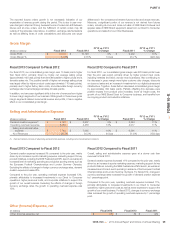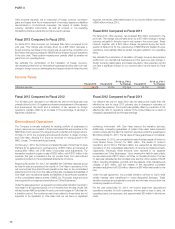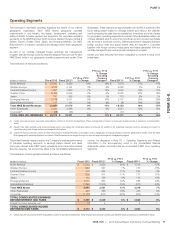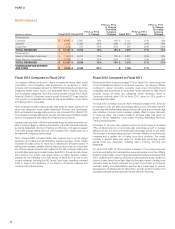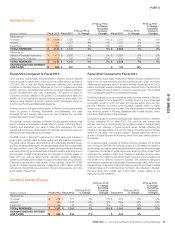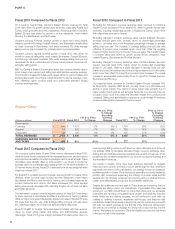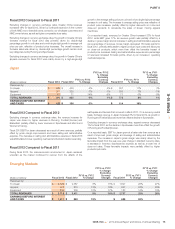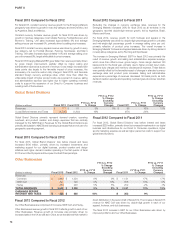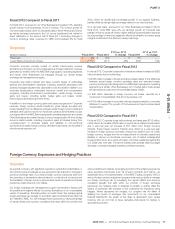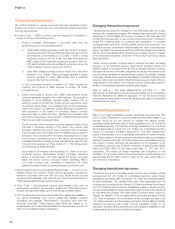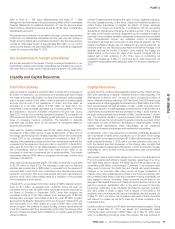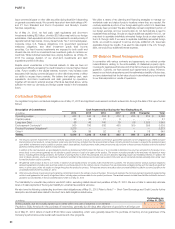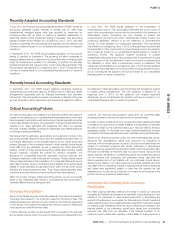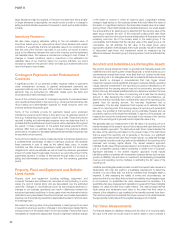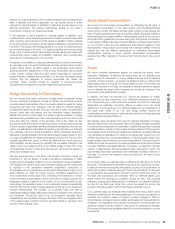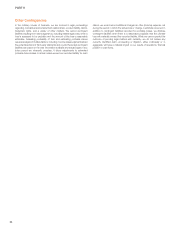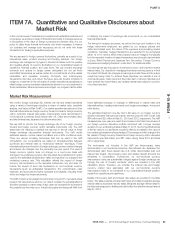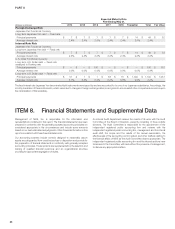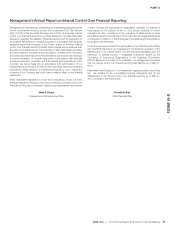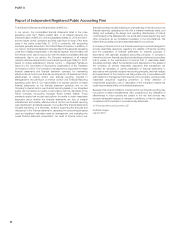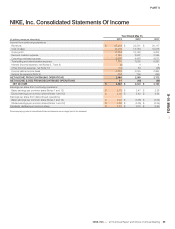Nike 2013 Annual Report Download - page 34
Download and view the complete annual report
Please find page 34 of the 2013 Nike annual report below. You can navigate through the pages in the report by either clicking on the pages listed below, or by using the keyword search tool below to find specific information within the annual report.
PART II
Refer to Note 6 — Fair Value Measurements and Note 17 — Risk
Management and Derivatives in the accompanying Notes to the Consolidated
Financial Statements for additional description of how the above financial
instruments are valued and recorded as well as the fair value of outstanding
derivatives at period end.
We estimate the combination of translation of foreign currency-denominated
profits from our international businesses and the year-over-year change in
foreign currency related gains and losses included in other (income) expense,
net had an unfavorable impact of approximately $56 million on our income
before income taxes for the year ended May 31, 2013 and had an insignificant
impact for the year ended May 31, 2012.
Net investments in foreign subsidiaries
We are also exposed to the impact of foreign exchange fluctuations on our
investments in wholly-owned foreign subsidiaries denominated in a currency
other than the U.S. Dollar, which could adversely impact the U.S. Dollar value
of these investments and therefore the value of future repatriated earnings.
We have hedged and may, in the future, hedge net investment positions in
certain foreign subsidiaries to mitigate the effects of foreign exchange
fluctuations on these net investments. In accordance with the accounting
standards for derivatives and hedging, the effective portion of the change in
fair value of the forward contracts designated as net investment hedges is
recorded in the cumulative translation adjustment component of accumulated
other comprehensive income. Any ineffective portion is immediately
recognized in earnings as a component of other (income) expense, net. The
impact of ineffective hedges was not material for any period presented. To
minimize credit risk, we have structured these net investment hedges to be
generally less than six months in duration. Upon maturity, the hedges are
settled based on the current fair value of the forward contracts with the
realized gain or loss remaining in OCI. There were no outstanding net
investment hedges as of May 31, 2013 and 2012. Cash flows from net
investment hedge settlements totaled $22 million for the year ended May 31,
2012.
Liquidity and Capital Resources
Cash Flow Activity
Cash provided by operations was $3.0 billion for fiscal 2013 compared to
$1.9 billion for fiscal 2012. Our primary source of operating cash flow for fiscal
2013 was net income of $2.5 billion. Our fiscal 2013 change in working capital
was a net cash outflow of $42 million, which is exclusive of working capital
amounts sold as part of the divestitures of Umbro and Cole Haan, as
compared to a net cash outflow of $799 million for fiscal 2012. Our
investments in working capital decreased due to slowing growth in inventory
and reductions in accounts receivable compared to the prior year. During
fiscal 2013, inventory for continuing operations increased 7% compared to a
23% increase for fiscal 2012; the slowing growth was driven by our continued
focus on increasing inventory productivity. The reduction in accounts
receivable was primarily driven by the collection of receivables related to
discontinued operations.
Cash used by investing activities was $1,067 million during fiscal 2013,
compared to a $514 million source of cash for fiscal 2012. A major driver of
the change was the swing from net sales/maturities of short-term investments
in fiscal 2012 to net purchases of short-term investments in fiscal 2013,
reflective of the additional purchases of short-term investments made with the
proceeds from the issuance of long term debt in April 2013. In fiscal 2012,
there were $1,124 million of net sales/maturities of short-term investments
(net of purchases), while in fiscal 2013 we made $1,203 million in net
purchases of short-term investments (net of sales/maturities). This impact
was partially offset by $786 million in proceeds from the sale of Umbro and
Cole Haan in fiscal 2013.
Cash used by financing activities was $1,040 million for fiscal 2013 compared
to $2,118 million for fiscal 2012. The decrease in cash used by financing
activities was primarily due to $986 million in proceeds from the issuance of
long-term debt in April 2013. Also contributing to the decrease were lower
payments of long-term debt and notes payable and lower repurchases of
common stock, which were partially offset by a reduction in the proceeds
from the exercise of stock options.
In fiscal 2013, we purchased 33.5 million shares of NIKE’s class B common
stock for $1.7 billion, an average price of $49.50. During the year, we
completed the four-year, $5 billion share repurchase program approved by
our Board of Directors in September 2008. Under that program, we
purchased a total of 118.8 million shares at an average price of $42.08.
Subsequently, we began repurchases under a four-year, $8 billion program
approved by the Board in September 2012. As of the end of fiscal 2013, we
had repurchased 15.3 million shares at a cost of $789 million under this
current program. We continue to expect funding of share repurchases will
come from operating cash flow, excess cash, and/or debt. The timing and the
amount of shares purchased will be dictated by our capital needs and stock
market conditions.
Capital Resources
On April 23, 2013, we filed a shelf registration statement (the “Shelf”) with the
SEC which permits us to issue an unlimited amount of debt securities. The
Shelf expires on April 23, 2017. On April 23, 2013, we issued $1.0 billion of
senior notes with tranches maturing in 2023 and 2043. The 2023 senior notes
were issued in an initial aggregate principal amount of $500 million at a 2.25%
fixed, annual interest rate and will mature on May 1, 2023. The 2043 senior
notes were issued in an initial aggregate principal amount of $500 million at a
3.625% fixed, annual interest rate and will mature on May 1, 2043. Interest on
the senior notes is payable semi-annually on May 1 and November 1 of each
year. The issuance resulted in gross proceeds before expenses of $998
million. We will use the net proceeds for general corporate purposes, which
may include, but are not limited to, discharging or refinancing debt, working
capital, capital expenditures, share repurchases, as yet unplanned
acquisitions of assets or businesses and investments in subsidiaries.
On November 1, 2011, we entered into a committed credit facility agreement
with a syndicate of banks which provides for up to $1 billion of borrowings
with the option to increase borrowings to $1.5 billion with lender approval. The
facility matures November 1, 2016, with a one-year extension option prior to
both the second and third anniversary of the closing date, provided that
extensions shall not extend beyond November 1, 2018. As of and for the year
ended May 31, 2013, we had no amounts outstanding under our committed
credit facility.
We currently have long-term debt ratings of A+ and A1 from Standard and
Poor’s Corporation and Moody’s Investor Services, respectively. If our long-
term debt rating were to decline, the facility fee and interest rate under our
committed credit facility would increase. Conversely, if our long-term debt
rating were to improve, the facility fee and interest rate would decrease.
Changes in our long-term debt rating would not trigger acceleration of
maturity of any then-outstanding borrowings or any future borrowings under
the committed credit facility. Under this committed revolving credit facility, we
have agreed to various covenants. These covenants include limits on our
disposal of fixed assets, the amount of debt secured by liens we may incur, as
well as a minimum capitalization ratio. In the event we were to have any
borrowings outstanding under this facility and failed to meet any covenant,
and were unable to obtain a waiver from a majority of the banks in the
syndicate, any borrowings would become immediately due and payable. As
of May 31, 2013, we were in full compliance with each of these covenants
and believe it is unlikely we will fail to meet any of these covenants in the
foreseeable future.
Liquidity is also provided by our $1 billion commercial paper program. During
the year ended May 31, 2013, we issued and subsequently repaid
commercial paper borrowings of $505 million. As of May 31, 2013, there
were no outstanding borrowings under this program. We may continue to
NIKE, INC. 2013 Annual Report and Notice of Annual Meeting 79
FORM 10-K


